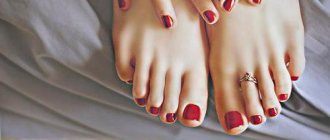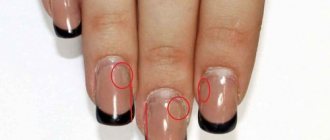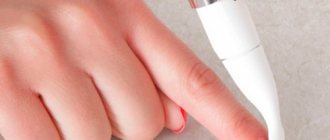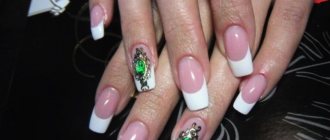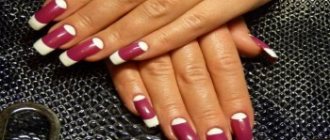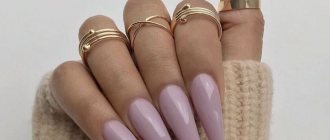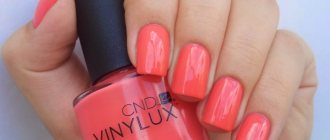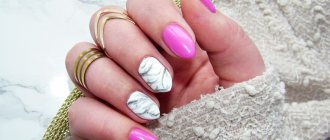Well-groomed hands and beautiful nails with a carefully thought-out design are the calling card of a modern fashionable woman. Tidy nails significantly improve self-esteem and mood, and give confidence in one’s own abilities. Moreover, a beautiful manicure increases a woman’s status and determines a friendly attitude. However, it is not always possible and time to regularly visit nail salons. It is not surprising that fashionistas are often concerned with the pressing question: “How to do a manicure at home?”
Experienced nail experts say: nothing is impossible. If you have good tools, special tools and minimal experience, the process of processing and decorating marigolds is always successful. You just need to not be afraid to try your hand, to “train your hand.” And recommendations from experts will help you master the beautiful and necessary art of nail design at a decent level.
View this post on Instagram
Posted by Unreel (@extremeofficial)
How to do a manicure at home: tools and products needed to perform it
It's no secret that the success of any job depends on correctly selected, high-quality tools. Nail care is no exception. The impeccable appearance of the fingers, the speed and correctness of the manicure depend on the tools. The traditional trimming technique requires:
- accessories for cutting cuticles and dead skin from the side rollers - manicure scissors, cuticle cutters with a flat blade. Also, the cuticle can be removed with clippers and a pusher with a sharp lance blade. The most famous and sought-after professional brand is Solinger brand products made of hard tool steel;
- pusher-pusher designed to move and lift the cuticle. It can be one-sided or two-sided. At one end there is always a paddle-shaped blade, and at the other there are tips with different purposes. For the cutting technique you will need a hatchet;
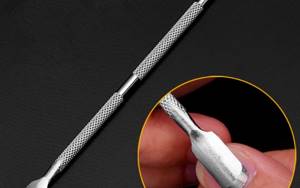
- It is convenient to use a clipper to trim the excess length of the plates. Depending on the length of the blades, it is used for manicures and pedicures. Thanks to its thoughtful design, it is one of the safest cutting tools;
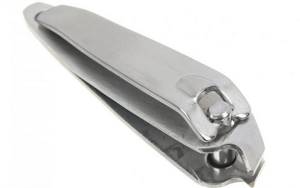
- files 180 grit. These units measure abrasiveness; the exact value must be indicated on the product itself. This file is used to contour the nails, sawing off the top layer of plates to make the surface rougher for better adhesion to the base;
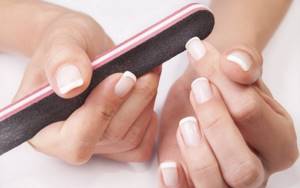
- polisher (buff) with abrasiveness 2000 grit. Most often it has the shape of a bar or a rounded, volumetric rhombus. There are models with 2-3 working surfaces for different purposes. In this case, the degree of abrasiveness is indicated for each side separately;
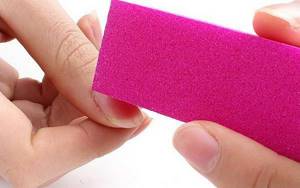
- disinfectants – 70% alcohol solution; chlorhexidine; pharmaceutical antiseptic for disinfection of hands, surfaces and instruments;
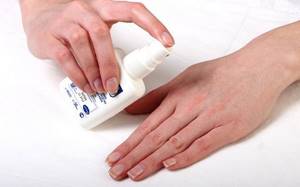
- wooden sticks for moving cuticles. Made from orange wood;
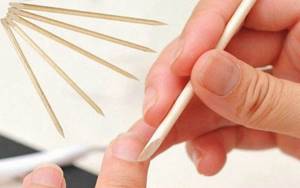
- nail polish remover;
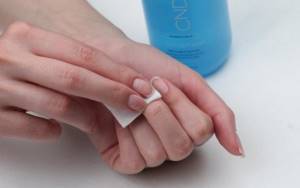
- soft, clean towel or napkins, cotton pads; voluminous ceramic container for caring procedures.
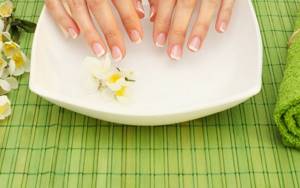
Follow the master’s requests regarding the nuances of the procedure
If the master asks you not to touch your hair and face with your hands after degreasing your nails, this is not a whim, but a condition for high-quality adhesion of the material. If you ignore it, you'll have to redo it. If the master asks you to place your hand in the lamp, you should not admire the undried color, otherwise it will flow and you will have to cut out the jamb.
And yes, if you feel that you touched something with your nail when you put your hand in the lamp, it is better to immediately show the nail to the nail technician rather than dry it. The problem will not magically disappear, but a dry nail is much easier to fix.
Well, now that you know all the rules for a quick manicure, it’s time to choose this season’s trendy manicure: 7 options for inspiration.
Selecting the right tools for manicure
Ladies taking their first steps in mastering nail care and nail design often make mistakes when choosing tools. Manufacturers offer a lot of devices, not all of which are useful or safe. What do experienced specialists recommend?
- Orange sticks are an excellent solution for working with cuticles and cleaning eponychium. They cause less injury to the skin and plate than their metal counterparts.
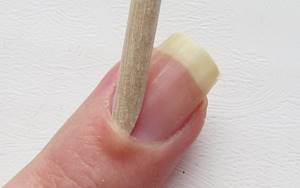
- It is best to trim raised cuticles with nippers - they are more convenient and do not leave hangnails.
- In theory, nail forks are supposed to remove cuticles. In practice, the sharp ends leave deep, bleeding scratches and catch living skin, wounding it. It is better to refuse them.
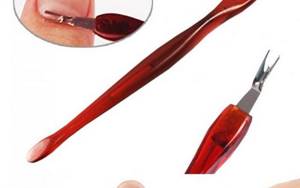
When choosing cutting tools, you need to pay attention to the quality of the steel and sharpening. Since no pressure is allowed on the nail plate area, the blades must be very sharp.
Files: types, purpose
- 80 grit – coarse, intended for filing artificial plates;
- 100-150 – medium, give shape to artificial nails;
- 180-240 – soft, for natural plates;
- 400-2000 – polishing buffs.
The file movements are carried out in one direction so that the edges do not become frayed, and always on a dry surface.

Forming a free edge
Shaping your nails is a great way to correct their imperfections and give them a more elegant, aristocratic appearance. The edges are filed symmetrically, the plates must have the same length.

Oval and square are suitable for any size, but almonds and other pointed shapes are best done on elongated nails.
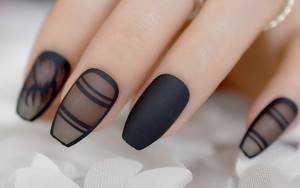
Cutting manicure technique
Step-by-step instructions:
- wash your hands, treat with an antiseptic;
- remove old varnish, degrease the records;
- in a bowl, steam the cuticle on the fingers of one hand, move it with a pusher;
- clean the pterygium, cut off the dead white skin on the ridges and cuticle;
- moisten the skin with oil.
If you don’t want to paint your nails, apply a layer of colorless base.
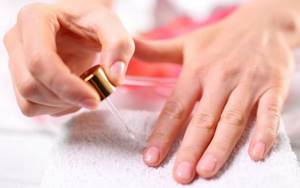
Or start nail design.
Fact about manicure
As a varnish for nail plates, the ancient Chinese used a mixture of beeswax, gelatin, egg whites and gum arabic resin. Natural dyes from rose petals and orchids were responsible for the color.
Gel nail extension:
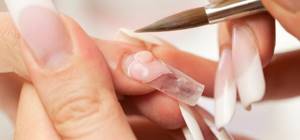
The most common material for nail extensions has long been gel - a material that has a natural composition and the necessary porosity. Why do the vast majority of clients choose gel nails?
- Gel nails look more natural
- The gel is odorless
- The material does not cause allergic reactions; when properly extended, the nails under the gel breathe, light, air and moisture enter them, which makes the development of fungus impossible
- This is a very multifunctional material. With its help you can extend French manicure, do sculpting and all types of decor. It can be used on tips even at home
- Has a high level of adhesion (adhesion) to the nail surface
- It lends itself well to filing, so the process does not take much time
- Gel nails are very strong and elastic, which prevents them from cracking and breaking at the slightest impact.
- When cracks appear, they can be corrected using special silk strips. However, experts still advise to grow the nail again in this case.
- Gel nail extensions can protect natural nail plates from the harmful effects of environmental factors.
Among the disadvantages, experts cite loss of resistance due to sudden changes in temperature and the lengthy process of removing them. No one yet knows why this happens and how to fix it.
There are plenty of arguments in favor, but before doing gel nail extensions, you need to contact a specialist for competent advice. He will determine whether your nails need gel extensions.
It remains to be seen what the technology itself actually looks like. This information will be especially useful for those who want to do such a procedure at home.
Untrimmed treatment of nails and skin during manicure
Performed without steaming, dry. Its peculiarity is that dead skin and cuticle are not cut off. To soften dead skin, special alkaline or acidic solutions are used. Before using the product, you must read the instructions. Some of the products need to be washed off, but soft fruit compositions can be left on, as they have a beneficial effect on the condition of the fingers. The softened cuticle is moved with sticks, and the rollers are polished with a buff.
European unedged technology:
- wash hands, disinfect;
- apply a creatolytic to the cuticle and rollers;
- Use a stick to move the rollers, sand with a 180 grit file;
- remove the softened cuticle with a stick;
- degrease nails with alcohol;
- Apply varnish in accordance with the chosen design.
View this post on Instagram
Posted by Unreel (@extremeofficial)
How to properly apply a layer of varnish during a manicure
Fresh gel polish is no hassle. It fits perfectly and dries quickly. If the composition has become thicker, it should be diluted by adding 3-5 drops of varnish solvent to the bottle. Do not use acetone or nail polish remover!
Bright and dark tones of varnishes: how to apply manicure correctly
- First, a base is applied to the plate.
- Apply varnish to the brush and rub it along the neck to remove excess.
- The brush is placed in the center, at an angle of 450. Lead from the center to the base. Then they pass along the same strip, to the free tip, without stopping, in a smooth movement, without lifting the instrument.
- The brush is placed at the beginning of the painted strip, perpendicular to the finger. Lead to the side, round and continue moving along the roller to the tip, coloring the edge. The same steps are repeated with the opposite edge of the nail.
- The bristles are squeezed out and passed along the end of the plate, “sealing” it.

Method of painting nails with pastel and nude thick varnishes:
- dip the brush and squeeze it onto the neck;
- place the plate vertically in the center, practically without touching it with the bristles, only with the applied varnish;
- lead to the cuticle, then along the same strip - up to the tip;
- place the brush in the cuticle area, paint the space near the side roller from the base upwards, without touching the skin;
- repeat the procedure on the other side of the nail, sealing the free edge.
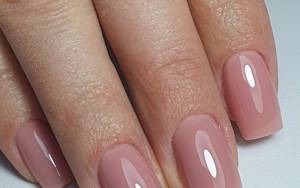
Classification of gel polishes by texture
All gel polishes are divided into 2 main categories:
- Reflective gel polishes. The main advantage is quick adhesion to the nail. Such tools are easy to use and easy for beginners to work with.
- Non-reflective gel polishes. In addition to this drug, an activating substance is also required. This type of gel polish has a glue-like texture. To dilute it, a special spray is required. And you need to apply this gel polish with a professional gel brush.
Which manicure design to choose
A number of beautiful techniques can be easily performed at home.
- Magnetic cat eye polishes are mesmerizingly beautiful. A magnet is held near a fresh layer of varnish for 1 second. The closer it is, the clearer the stripe.
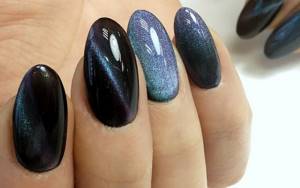
- Hard varnish “Crackelure”, which cracks, forming a bizarre relief pattern.
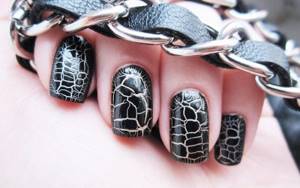
- Matte satin that masks all the imperfections of the plates. You can apply a glossy top coat on top or leave a velvety surface.
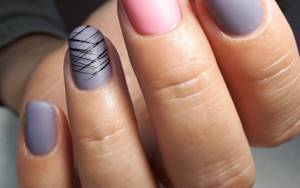
- Imitation leopard skin. Uneven spots of a darker shade are applied to the dried neutral background, which are framed with black “commas”.

- The zebra is made with contrasting varnish on a white or light pastel background.
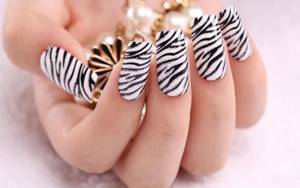
- A wide selection of stickers, stamps and stencils allow you to create stunning home designs.

- To decorate your nails with stones, they are placed on fresh, undried varnish. Crystals are taken using a damp toothpick or stick.
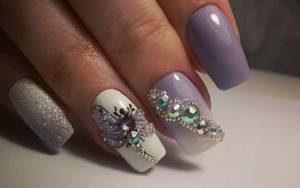
Another universal option for all occasions is glitter or acrylic powder.
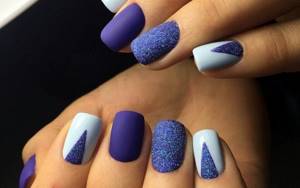
How and how to disinfect manicure instruments at home
In salons, all instruments are processed under lamps or in a dry-heat apparatus. At home you can use:
- oven. At a temperature of 2500, treatment lasts a quarter of an hour;
- If blood gets on the blade, before heat treatment it is washed, soaked in chlorhexidine or alcohol.
It is better to use disposable files and sticks or soak them in antiseptic.

What medical supplies may be needed
- To disinfect hands and instruments, you can use a 70% tincture with hawthorn.
- Mountain celandine balm helps against warts.
- If a wound is accidentally caused, use special glue BF-6.
